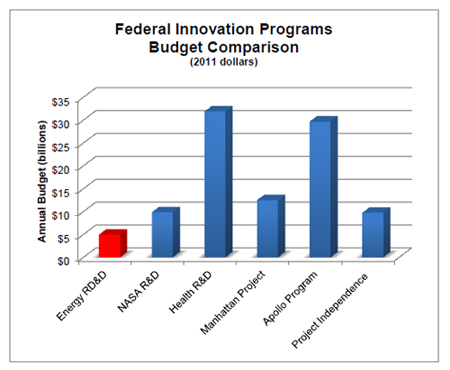Innovation Drives Investment, Job Growth, Manufacturing
Innovation is the engine of American prosperity. Economists estimate that up to 80 percent of modern economic growth arises from technological innovation, the process of developing new knowledge and harnessing discoveries to create better commercial products, more productive and competitive industries, and well-paying jobs.
Over the past century, the federal government has played a vital role in supporting innovation through public-private partnerships and targeted investments in science and technology. These investments have produced enormous economic returns and strengthened U.S. leadership in several important industries, including information technology, communications, aviation, medicine, and agriculture, among others.
Today, leadership in advanced energy technology is a national imperative. Global energy demand will grow by nearly 50 percent over the next 25 years, presenting a multitrillion-dollar market opportunity. In the next decade alone, the global market for clean power assets could total $2.3 trillion. In short, clean energy is quickly becoming a major growth sector, and countries such as China and Germany are moving quickly to capture this opportunity.
To win the future jobs and economic benefits of this growth sector, the United States needs a national energy innovation strategy—one that unleashes our scientific and technological strength to develop cheaper forms of clean energy, manufacture these products at home, and export them. Unfortunately, the nation has not yet defined energy innovation as a core priority. The public and private sectors have made progress in recent years, but without a stronger, long-term commitment, the United States risks falling behind.
The Energy Innovation Gap
 The federal government can support energy innovation through a variety of policy mechanisms. Yet one key metric stands above the rest as an indicator of the nation's commitment to any technology sector: the scale and structure of its investments in research, development, and demonstration (RD&D). On this front, the public and private sectors have dramatically underinvested for decades. For example:
The federal government can support energy innovation through a variety of policy mechanisms. Yet one key metric stands above the rest as an indicator of the nation's commitment to any technology sector: the scale and structure of its investments in research, development, and demonstration (RD&D). On this front, the public and private sectors have dramatically underinvested for decades. For example:
- Federal energy RD&D investment has fallen significantly since the late 1970s and today totals only $5 billion a year in all energy-related activities.
- In contrast, the federal government currently spends $8 billion annually on space-related R&D, more than $30 billion on health-related research (doubling since 1996), and $80 billion on defense R&D.
- Annual federal investment (in 2011 dollars) was $12.5 billion for the Manhattan Project, $30 billion for the Apollo program, and $10 billion for Project Independence, President Nixon's program to reduce reliance on imported oil.
Private R&D spending as a share of sales in the energy industry is only 0.4 percent, compared with 20.5 percent in pharmaceuticals, 11.5 percent in aerospace and defense, 7.9 percent on computers and electronics, and 2.4 percent in the automotive industry. The private sector consistently underinvests in RD&D activities, because it is often unable to capture all the benefits of its investments. This underinvestment is especially prevalent in the energy sector. Energy is much more capital-intensive than other industries, requiring high upfront expenses and relatively low rates of return; energy markets are dominated by large, risk-averse firms and are not favorable to new competition; and consumers are largely unwilling to pay higher prices for new technologies.
Recognizing this gap, a wide range of business leaders, economists, scientists, and policy analysts have reached a consensus: The federal government should triple its investments in energy RD&D from approximately $5 billion to $15 billion annually. This shared vision includes individuals and trade groups from across the political spectrum, such as the American Energy Innovation Council, President's Council of Advisors on Science and Technology, American Enterprise Institute, Brookings Institution, Bipartisan Policy Center, dozens of Nobel scientists, and several other nongovernmental institutions.
Enhanced Energy Innovation Can Lead to Job Growth, Cut Oil Consumption
Fortunately, the United States still possesses unrivaled innovation capacity, from world-renowned scientists and research universities to extensive venture capital markets and entrepreneurial initiative. This country is positioned to reap enormous benefits from a greater commitment to energy innovation—including enhanced economic competitiveness, national security, and public health. Some of these benefits are already materializing.
For example, according to a Brookings Institution analysis, the highest job growth and export intensity in overall clean economy is occurring in emerging energy technologies such as solar photovoltaics, solar thermal, wind, biofuels, fuel cells, and smart grids. In fact, 78 percent of all clean economy jobs created between 2003 and 2010 came from ventures established after 2002. In 2011, the United States attracted 70 percent of worldwide venture capital investments. Yet these developments are only scratching the surface. According to a McKinsey & Co. analysis, breakthroughs in just a few key energy technologies would create more than 1 million U.S. jobs, save households nearly $1,000 in annual energy costs, add $155 billion to gross domestic product (GDP), and cut domestic oil consumption by at least 1.1 billion barrels annually.
Seizing the Opportunity
To help seize the opportunity, Americans for Energy Innovation, a project of the Pew Clean Energy Program, aims to build support for federal policies that drive innovation in clean energy technologies to strengthen U.S. economic competitiveness, defense, and environmental security. This project builds support for the following goals:
- In the short-term, preserve and optimize existing federal energy RD&D programs, especially ARPA-E, Energy Innovation Hubs, Energy Frontier Research Centers, the Office of Science, the Office of Energy Efficiency and Renewable Energy, and Department of Defense energy programs.
- In the long-term, increase federal investment in clean energy RD&D to build upon the success of current programs and harness new institutional models to incrementally expand the energy RD&D budget to $15 billion annually.
Investing in Innovation: A History of National Success
Federal investments in research and development have consistently achieved technological breakthroughs and launched successful industries. A few examples include:
- The Internet. The precursor to the Internet was the Advanced Research Projects Agency Network (ARPANET), formed in the late 1960s and directly funded by the Department of Defense. Developed in U.S. universities and research laboratories, ARPANET was the world's first operational packet-switching network, comprising the core that eventually spawned the global Internet. Between 2004 and 2009, the Internet was responsible for a full 15 percent of U.S. GDP growth.
- Biotechnology. The research and development of recombinant DNA technology, which launched Genentech and the U.S. biotech industry, was supported in the early 1970s by the National Science Foundation and National Institutes of Health. More broadly, according to the U.S. Congress Joint Economic Committee, federal research funding was instrumental in developing 15 of the 21 drugs introduced between 1965 and 1992 that had the highest therapeutic impact on society, saving tens of thousands of lives and producing billions of dollars in revenue for U.S. companies.
- Energy efficiency. According to the National Research Council, investments of about $1.6 billion from 1978 to 2000 in U.S. energy efficiency activities and programs resulted in net realized economic benefits of about $30 billion in savings to Americans. Made over 20 years, these investments, in windows, fluorescent light ballasts, and advanced refrigerator compressors, returned almost $20 for every $1 invested.






